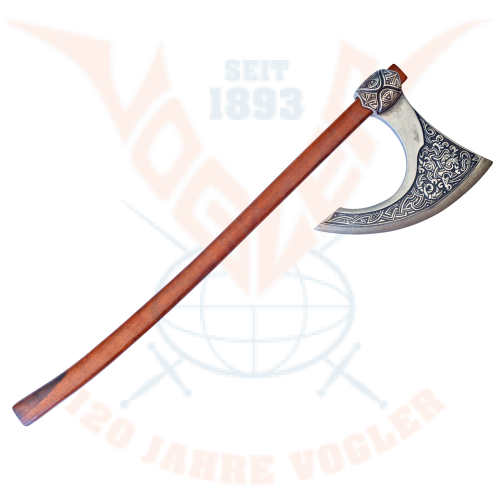
The Bayeux Tapestry also depicts a huscarl cleaving a Norman knight's horse's head with one blow. A Dane axe, perhaps King Edward's, is offered to Harold before he is crowned. These huscarls formed the core bodyguard of King Harold at the Battle of Hastings. In the Bayeux tapestry, a visual record of the ascent of William the Conqueror to the throne of England, the axe is almost exclusively wielded by well armoured huscarls. Historical accounts may depict the Dane axe as the weapon of some of the warrior elite in this period, such as the Huscarls of Anglo-Saxon England. Through the course of the 9th–11th centuries, the Dane axe began to gain further popularity outside of Scandinavia, either through Viking trade or influence or independent developments such as England, Ireland and Normandy. Ash and oak are the most likely materials for the haft, as they have always been the primary materials used for polearms in Europe. Some surviving examples also feature a brass haft cap, often richly decorated, which presumably served to keep the head of the weapon secure on the haft, as well as protecting the end of the haft from the rigours of battle. Such axes might also feature inlaid silver and frequently do not have the flared steel edge of a weapon designed for war. 0.9 and 1.2 m (3.0 and 3.9 ft) long, although Dane axes used as status symbols might be as long as 1.5 to 1.7 m (5 to 5½ ft).

forged thin and incorporating a harder type of steel near the edge) results in a lively and quick weapon with devastating cutting ability.īased on period depictions, the haft of a longaxe for combat was usually between approx. Proportionally, the long axe has more in common with a modern meat cleaver than a wood axe. Average weight of an axe this size is between 1 and 2 kg (2.2 and 4.4 lb). Many of these axes were constructed with a reinforced bit, typically of a higher carbon steel to facilitate a harder, sharper edge. The thickness of the body on top the edge is as thin as 2 mm.

The blade itself was reasonably light and forged very thin, making it superb for cutting. Later type M blades are typically larger overall, with a more symmetrical toe and heel. Type L blades tend to be smaller, with the toe of the bit swept forward for superior shearing capability. Cutting surfaces vary, but is generally between 20 and 30 cm (8 and 12 in). Both types consist of a wide, thin blade, with pronounced "horns" at both the toe and heel of the bit. Most axes, both in period illustrations and extant artifact, that fall under the description of Danish axe possess type L or type M heads according to the Petersen axe typology.


 0 kommentar(er)
0 kommentar(er)
